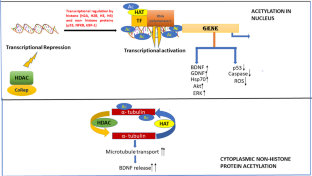Molecular Neurobiology ( IF 5.1 ) Pub Date : 2024-04-08 , DOI: 10.1007/s12035-024-04115-6 Richa Singh , Aaina Singh Rathore , Hagera Dilnashin , Priyanka Kumari Keshri , Nitesh Kumar Gupta , Singh Ankit Satya Prakash , Walia Zahra , Shekhar Singh , Surya Pratap Singh

|
In view of the increasing risk of neurodegenerative diseases, epigenetics plays a fundamental role in the field of neuroscience. Several modifications have been studied including DNA methylation, histone acetylation, histone phosphorylation, etc. Histone acetylation and deacetylation regulate gene expression, and the regular activity of histone acetyltransferases (HATs) and histone deacetylases (HDACs) provides regulatory stages for gene expression and cell cycle. Imbalanced homeostasis in these enzymes causes a detrimental effect on neurophysiological function. Intriguingly, epigenetic remodelling via histone acetylation in certain brain areas has been found to play a key role in the neurodegenerative diseases such as Alzheimer’s disease, Parkinson’s disease, and Huntington’s disease. It has been demonstrated that a number of HATs have a role in crucial brain processes such regulating neuronal plasticity and memory formation. The most recent therapeutic methods involve the use of small molecules known as histone deacetylase (HDAC) inhibitors that antagonize HDAC activity thereby increase acetylation levels in order to prevent the loss of HAT function in neurodegenerative disorders. The target specificity of the HDAC inhibitors now in use raises concerns about their applicability, despite the fact that this strategy has demonstrated promising therapeutic outcomes. The aim of this review is to summarize the cross-linking between histone modification and its regulation in the pathogenesis of neurological disorders. Furthermore, these findings also support the notion of new pharmacotherapies that target particular areas of the brain using histone deacetylase inhibitors.
中文翻译:

HAT 和 HDAC:在神经退行性疾病中作用相反的酶
鉴于神经退行性疾病的风险不断增加,表观遗传学在神经科学领域发挥着基础作用。已经研究了多种修饰,包括DNA甲基化、组蛋白乙酰化、组蛋白磷酸化等。组蛋白乙酰化和脱乙酰化调节基因表达,组蛋白乙酰转移酶(HAT)和组蛋白脱乙酰酶(HDAC)的常规活性为基因表达和细胞周期提供调节阶段。这些酶的体内平衡失衡会对神经生理功能产生不利影响。有趣的是,人们发现某些大脑区域通过组蛋白乙酰化进行的表观遗传重塑在阿尔茨海默病、帕金森病和亨廷顿病等神经退行性疾病中发挥着关键作用。已经证明,许多 HAT 在调节神经元可塑性和记忆形成等关键大脑过程中发挥着作用。最新的治疗方法涉及使用称为组蛋白脱乙酰酶 (HDAC) 抑制剂的小分子,其拮抗 HDAC 活性,从而增加乙酰化水平,以防止神经退行性疾病中 HAT 功能的丧失。目前使用的 HDAC 抑制剂的靶标特异性引起了人们对其适用性的担忧,尽管该策略已显示出有希望的治疗结果。本综述的目的是总结组蛋白修饰及其在神经系统疾病发病机制中的调节之间的交联。此外,这些发现还支持使用组蛋白脱乙酰酶抑制剂针对大脑特定区域的新药物疗法的概念。



























 京公网安备 11010802027423号
京公网安备 11010802027423号